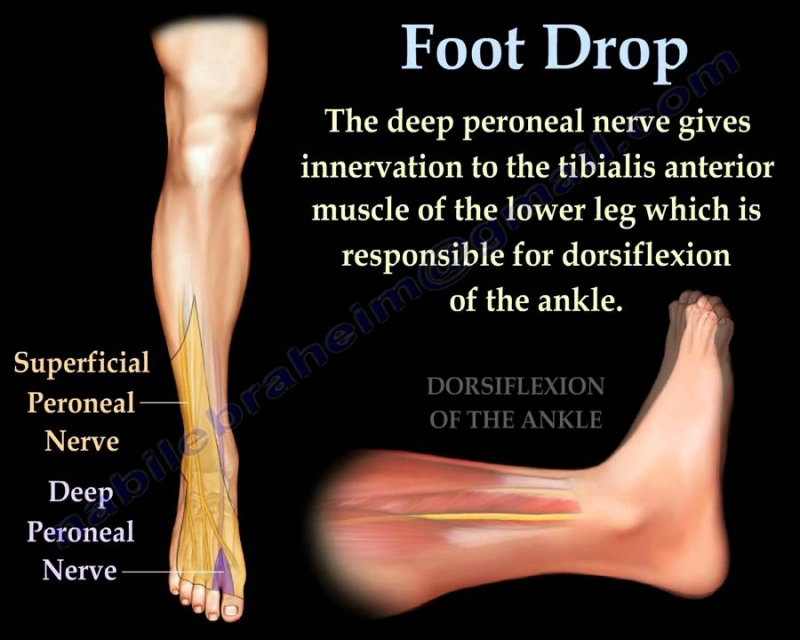
Foot drop is a general term for difficulty faced by certain people in lifting the front part of the foot. Rather than being classified as a disease in itself, Foot Drop is a symptom of an underlying neurological, anatomical or muscular issue. The front part of the foot may often be seen dragging on the ground when the patients of Foot Drop walk. . PAL Physiotherapy has the best foot drop treatment in Gurgaon with top physiotherapists having 14+ years of experience. In order to avoid dragging the toes, people suffering from this disorder may lift their knee higher than normal or swing their leg in an arc of wide curvature. Call at 9811343417 and Book your appointment at PAL Physiotherapy.
The condition may be temporary or permanent, varying from patient to patient. It generally depends on the extent of weakness of the affected muscles. Some patients may even need to wear a brace on their ankle and foot to hold it in a normal position. It may attack one foot or both feet at the same time and can be spotted in patients of any age.
Although the condition can have many different causes, general weakness or paralysis of the muscles lifting the foot are believed to be two of the most common culprits.
Weakness or paralysis of the muscles involved in lifting the front part of the foot is one of the primary causes of Foot Drop. It is not considered as a disease or disorder in itself and is often taken as a symptom of a deeper underlying problem. Thus, it serves as an indicator and can be temporary or permanent depending on the extent of weakness of the affected muscles.
Some of the most common causes of Foot Drop are -
The most prominent symptom of Foot Drop is the patient dragging their toes along the ground or bending their knees to lift their foot higher than usual to avoid the dragging.
The difficulty caused by Foot Drop in lifting the front part of the foot can cause the patient to raise their thigh as and when they walk. Thus, the disorder is often characterized by steppage gait. This unusual gait may make the patient slap their foot down onto the floor with each step.
In some cases of Foot Drop, the skin on the top of the foot and toes may go somewhat numb. Depending on the underlying cause of the disease, one or both feet may be affected.
The diagnosis of Foot Drop is mostly based on a physical examination of the patient. The patient often displays difficulty walking on their heels because of the inability to lift the front of the foot off the ground. A physical examination involving the patient being asked to dorsiflex may confirm the presence of the problem with high degree of accuracy. This is usually measured on a scale of 0-5 observing mobility. The lowest point - 0 - indicates complete paralysis while the greatest point - 5 - is a measure of complete mobility.
In case, the physical examination alone is not sufficient, some tests like MRI, MRN, or EMG may be performed on the patient to determine the underlying etiology for this diagnosis and accurately assess the surrounding areas of damaged nerves and the damaged nerves themselves, respectively.
Another possible cause of Foot Drop is an overgrowth of bone in the spinal canal or the presence of a tumor or cyst pressing on the nerve in the knee or spine. Imaging tests of the sort of X-Ray, ultrasound or CT Scan can help pinpoint identify these types of problems.
There is no fixed treatment for Foot Drop. It varies from patient to patient and depends on the underlying cause. If the cause is successfully identified and treated, the patient may display rapid improvement and the problem can even completely disappear. If the cause can't be treated or in some cases - identified, Foot Drop can be permanent.
Physiotherapy has been found extremely useful for the patients of Foot Drop. Physical therapy to strengthen the foot, ankle, and lower leg muscles is the primary treatment for Foot Drop in Gurgaon and is generally Muscle Stimulation Therapy, Muscle reeducation Therapy and Strengthening. Stretching and range of motion exercises performed by the patient during physiotherapy sessions will also help prevent any stiffness from developing in the heel.
Pal Physiotherapy have the best Foot Drop specialist in Gurgaon who do the proper treatment with their patients in a friendly manner. Some patients are suggested to wear a brace or splint fitting their ankle and foot well, thus helping them hold it in a normal position. Stimulation of nerve lifting the foot is also one of the most common approaches towards treatment of this disorder.
Getting your problem assessed by a skilled physical therapist can save you from a lot of inconvenience. Regularly scheduled physiotherapy sessions can improve functional mobility related to walking.
In addition to general foot exercises, the physical therapist may use various treatment modalities in order to improve the functioning of your anterior tibialis muscle. To help improve the way your muscles contract and lift your foot, neuromuscular electrical stimulation (NMES) may be used. This is a type of electrical stimulation which artificially contracts your muscles to help re-educate them to contract properly. NMES treatments are often accompanied by ankle exercises.
